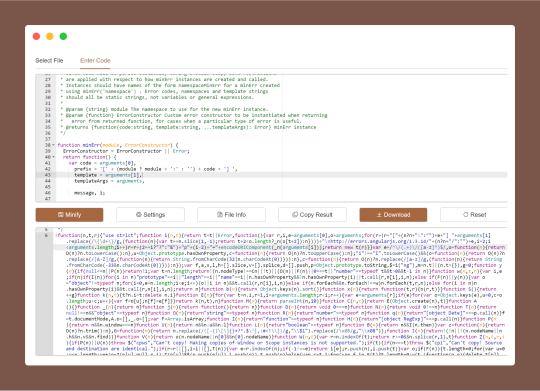#optimize javascript
Explore tagged Tumblr posts
Text
Total Blocking Time (TBT)
Learn everything about Total Blocking Time (TBT) – a critical web performance metric. Understand how it’s measured, why it matters, how to improve it, and its impact on user experience and SEO. Total Blocking Time (TBT) | Improve Website Interactivity & Performance Understanding Total Blocking Time (TBT): A Comprehensive Guide 1. Introduction to Web Performance The web has evolved rapidly,…
#core web vitals#improve TBT#JavaScript performance#long tasks#main thread blocking#optimize JavaScript#reduce TBT#site speed optimization#TBT#TBT SEO#TBT vs FID#Total Blocking Time#web performance metrics#web vitals guide#website interactivity
0 notes
Text
How to Optimize JavaScript for Faster Page Loads
JavaScript plays a critical role in modern web applications, powering everything from UI interactions to backend communication. However, poorly optimized JavaScript can significantly affect load times, especially on mobile or slow connections. As user experience and Core Web Vitals become essential SEO factors, developers and businesses are prioritizing script performance more than ever.
In this guide, we’ll explore key techniques for optimizing JavaScript, helping you reduce load time and improve responsiveness — a standard practice followed by leading JavaScript development companies.
1. Minify and Compress JavaScript Files
Minification removes unnecessary characters (like whitespace and comments) from JavaScript files, reducing file size without affecting functionality.
Use tools like:
UglifyJS
Terser
Google Closure Compiler
For additional compression, enabling Gzip or Brotli on your server ensures your JavaScript files are delivered in a smaller, compressed format.
Many top JavaScript development companies automate this process via build tools like Webpack or Gulp to streamline deployment.
2. Eliminate Unused JavaScript
Dead code or libraries that aren't being used can unnecessarily bloat your files. Audit your codebase and remove:
Unused functions or variables
Legacy plugin scripts no longer in use
Entire libraries if only a small utility is needed
Tools like Chrome DevTools or Lighthouse can help identify unused JavaScript. Expert teams at JavaScript development companies often use tree-shaking and modular design patterns to prevent this issue altogether.
3. Defer or Async JavaScript Loading
Using the defer or async attribute when loading JavaScript files ensures that scripts don’t block HTML rendering.
async loads the script asynchronously but doesn’t guarantee execution order.
defer ensures scripts run after the HTML is parsed, in the correct order.
Example:
html
CopyEdit
<script src="main.js" defer></script>
Strategically applying this across third-party and custom scripts can dramatically reduce render-blocking behavior.
4. Bundle and Split JavaScript Code
Bundling reduces HTTP requests by combining JavaScript files, while code-splitting ensures users only load the code necessary for the current page.
Modern bundlers like Webpack, Parcel, and Vite allow smart code-splitting. This technique is widely adopted by top JavaScript development companies to deliver faster, leaner applications across multiple devices.
5. Use a CDN to Deliver JavaScript
Content Delivery Networks (CDNs) distribute JavaScript files across geographically diverse servers. This reduces latency by serving users from the nearest server, improving load speed.
Additionally, shared libraries like React or jQuery served via CDN are often already cached in users' browsers from previous visits to other sites.
6. Optimize Third-Party Scripts
Analytics, chatbots, marketing trackers — these third-party scripts often run outside your control but significantly impact performance.
To optimize:
Load them after critical content.
Use tag managers with built-in performance settings.
Monitor their impact using performance tools.
Top-performing JavaScript development companies routinely audit these integrations to strike a balance between functionality and performance.
7. Avoid Inline JavaScript and DOM Manipulation on Load
Minimize inline scripts and avoid extensive DOM manipulation during initial page load. Inline scripts block rendering and increase Time to Interactive (TTI).
Instead:
Use event listeners that trigger after page load.
Use frameworks or vanilla JavaScript for efficient DOM handling.
8. Lazy Load Non-Essential Features
Don’t load everything upfront. Features like sliders, comment sections, or offscreen widgets can be loaded when needed.
Lazy loading reduces initial bundle size and allows faster first-paint experiences — a principle JavaScript development companies implement when building modern SPAs or PWA platforms.
9. Monitor and Continuously Improve
Use performance monitoring tools like:
Google Lighthouse
WebPageTest
SpeedCurve
Chrome DevTools
Regular audits and performance reviews help maintain a fast experience. Leading JavaScript development companies often integrate these tools into their CI/CD pipelines for consistent speed checks.
Conclusion
JavaScript optimization isn’t just about performance—it’s about user experience, SEO, and long-term scalability. Whether you’re building a single-page app or a high-traffic eCommerce platform, faster scripts lead to happier users and better conversions.
By implementing these strategies, your development workflow can align with the performance standards set by the top JavaScript development companies worldwide. Investing in optimization is not only beneficial — it's essential in today’s digital environment.
0 notes
Text
Minecraft Java players when Mojang fixes a bug that only affects a small part of the game: OMG LITERALLY UNPLAYABLE!!1! MOJANG HATES JAVA CLEARLY BEDROCK IS THEIR FAVORITE!!!1!!!1! :( Minecraft Bedrock players when Mojang changes a perfectly fine part of the game to be more like Java for no reason for the thousandth time: Well, as long as its for parity ¯\_(ツ)_/¯
#literally java players whine and moan their asses off when mojang changes a part of the game that no one cares about#but when mojang gets rid of all the awesome exclusives that bedrock has and actively downgrades the game in the name of “parity” we just#have to sit there and take it#and java players complain that mojang favors bedrock when they very clearly dont#like if the favor bedrock then why does java get bugfixes and updates and fully featured snapshots first?#why doesnt bedrock get any of the good parity features like building on the nether roof or a more featured custom world creator?#why does java get optimization updates while you can barely play bedrock on half of the devices its “supported” on?#why cant you play bedrock on linux even though its written in c++ which is much easier to port to linux than javascript?#anyways java players not be whiny bitches with superiority complexes challenge (impossible)#minecraft#minecraft bedrock#minecraft java#mojang
3 notes
·
View notes
Text
#website development#web design#app development#search engine optimization#content marketing#digital marketing#email marketing#graphic design#.net#php#javascript
0 notes
Text
Does learning Java increase my salary?
1. Introduction to the Java Job Market
Java is still one of the hottest programming languages out there. Whether you're just starting or have been coding for a while, knowing Java can really help your career. A common question is: Does learning Java boost my paycheck? The answer is yes—companies really want people who know Java because it's so flexible for web, mobile, and big business apps. Key topics include Java programming, Java developers, and job roles related to it.
Key Point: Java skills are in demand across different industries and can help increase your salary.
2. Java's Popularity and Market Demand
Big names like Amazon, Netflix, and Google use Java because it handles large-scale apps well. So, does learning Java increase my salary? Definitely. Employers will pay a premium for those who are good at Java. Key terms include Java software development, full stack, and backend developer.
Key Point: There’s a strong demand for Java devs, which leads to better pay and job security.
3. Java Skills and Salary Growth
Having Java skills gives you an edge. Companies are looking for people who know frameworks like Spring Boot and tools like Maven. Will learning Java increase my salary? For sure. With the right certifications and experience, you can earn more. And signing up for a Java course in Coimbatore can really help solidify your skills.
Key Point: Specialized Java knowledge can lead to promotions and salary increases.
4. Role of Certifications in Salary Hike
Getting a Java certification is a smart way to stand out. A lot of people choose the Java Full Stack Developer Course in Coimbatore for hands-on practice. Certifications prove your skills, and the answer to the question: Does learning Java bump up my salary? Yes.
Key Point: Java certifications help validate your skills and can lead to better pay.
5. Java Job Roles and Their Pay Scales
Java jobs range from junior developers to senior architects, and each level comes with higher pay. A Java training in Coimbatore can get you ready for roles like Full Stack Developer or Software Engineer. Is there a salary increase if you learn Java? Absolutely, especially for specialized roles.
Key Point: There are many roles in Java, and each offers attractive salary packages.
6. Java vs. Other Programming Languages in Salary
Java developers often earn more than those working with less popular languages. Unlike some newer languages, Java jobs tend to be more stable. Does learning Java mean better pay? Yes, compared to other languages, Java usually offers more consistent salaries.
Key Point: Java's long-standing presence in the industry generally means better pay than many newer languages.
7. Full Stack Java Developer Salary Benefits
Full Stack Java Developers are among the best paid in tech. Taking a Java Full Stack Developer Course in Coimbatore can prepare you for the job market. Will learning Java increase my salary? For sure—especially in full stack roles where you need to be skilled in both backend and frontend.
Key Point: Full Stack Java positions offer top salaries and are in high demand.
8. Java's Role in Enterprise Applications
Java is key for many enterprise systems. Learning enterprise-level Java can really answer the question: Does it help me earn more? Yes. A training program in Coimbatore that teaches things like Hibernate and JSP is worth considering.
Key Point: Skills in enterprise Java can set you up for well-paying jobs.
9. Local Training Institutes and Career Impact
Joining a local Java course in Coimbatore can boost your earnings. These programs offer hands-on projects and guidance from experts. So, does learning Java help with salary? Yes—local training can lead to quicker job growth.
Key Point: Local Java training can speed up your skills and help with job placements.
10. Final Thoughts and Brand Mention
In summary, does learning Java increase my salary? Yes, through certifications, full stack skills, and local training. Consider a reputable place like Xplore It Corp for training in Coimbatore, offering courses designed to meet job market needs.
Key Point: Xplore It Corp provides practical Java courses that can help you earn more.
FAQs:
1. Does learning Java help me earn more with no experience?
Yes. Even beginners can get better job offers after certified Java training.
2. What’s the average salary after a Java course in Coimbatore?
Freshers typically earn around ₹3-5 LPA, and pay can increase significantly after 1-2 years.
3. Is a Java Full Stack Developer Course in Coimbatore worth it?
Definitely. Full stack developers are in demand and usually earn 20-30% more.
4. How long before I see salary benefits after Java training?
Usually, you can expect to see salary increases within 6-12 months after completing the course.
5. Can I switch to Java and expect a pay increase?
Yes. Many people move from non-tech jobs to Java and see a boost in their salary.
#Java programming#Java developer#Java applications#Core Java#Java certification#Java frameworks#Spring Framework#Java full stack#Java backend developer#Java software development#Java training course#Java job roles#Object-oriented programming#Java IDE#Java runtime environment#Java REST API#J2EE#Java vs Python#Java vs JavaScript#Secure Java coding#Java deployment#Java enterprise solutions#Java bootcamp#Java multithreading#Java performance optimization
0 notes
Text
11 SEO Lessons Learned From Auditing 500+ Websites
Discover 11 powerful SEO lessons from auditing over 500 websites. Learn how to fix technical issues, improve crawlability, boost Core Web Vitals, and avoid common SEO mistakes. 11 Easy SEO Lessons Learned From Auditing 500+ Websites I’ve been doing SEO audits for over 12 years. During this time, I’ve reviewed more than 500 websites—from small blogs to giant ecommerce stores. And you know what I…
#core web vitals#crawl budget#internal linking#JavaScript SEO#keyword cannibalization#log file analysis#on-page SEO#schema markup#search engine optimization#SEO audit checklist#SEO insights#SEO lessons#technical SEO#thin content#website audit
0 notes
Text

JS Minifier is a web-based code optimize tool that reduces the size of JavaScript (JS) files by removing unnecessary characters like whitespace, comments, and line breaks, improves website performance by decreasing load times and bandwidth usage.
#JS Minifier#JavaScript Minifier#JavaScript Compressor#Minify JavaScript Online#JavaScript Code Minifier#Reduce JavaScript File Size#Free JavaScript Minifier Tool#JS Optimizer#Terser JS Minifier#free online tools#online tools#web tools#online web tools#free web tools#online tool#a.tools
0 notes
Text
#web development#education#search engine marketing#search engine optimization#laravel#php#html#css#javascript#jquery
1 note
·
View note
Text
#Technology Magazine#Free Online Tool#Interactive Tools and Collection#Internet Tools#SEO Tools#Learn Search Engine Optimization#Computer Tips#Freelancer#Android#Android Studio#BlogSpot and Blogging#Learn WordPress#Learn Joomla#Learn Drupal#Learn HTML#CSS Code#Free JavaScript Code#Photo and Image Editing Training#Make Money Online#Online Learning#Product Review#Web Development Tutorial#Windows OS Tips#Digital Marketing#Online Converter#Encoder and Decoder#Code Beautifier#Code Generator#Code Library#Software
0 notes
Text

How to Balance Fixing Performance Issues and Adding New Features in Web Applications?
In today’s digital landscape, web applications are essential for business operations, marketing, and consumer involvement. As organizations expand and consumer expectations rise, development teams are frequently confronted with the difficult task of balancing two key priorities: addressing performance issues and introducing new features.
While boosting performance improves the user experience and increases efficiency, new features are required to remain competitive and meet market demands. Prioritizing one over the other, on the other hand, might have negative consequences—performance concerns can lead to a poor user experience while failing to innovate can result in a competitive disadvantage.
This blog delves into how to balance improving performance and introducing new features to web apps, allowing firms to satisfy technical and market demands efficiently.
Why Balancing Performance and New Features Is Crucial
A web application‘s success depends on both its performance and its features. However, relying entirely on one might result in imbalances that impair both user happiness and business progress.
Performance:Performance is an important component that directly influences user retention and happiness. Users can become frustrated and leave if the application has slow loading times, crashes, or problems. Ensuring that your web application runs smoothly is essential since 53% of mobile consumers would quit a site that takes more than three seconds to load.
New Features:On the other hand, constantly adding new features keeps users interested and promotes your company as innovative. New features generate growth by attracting new consumers and retaining existing ones who want to experience the most recent changes.
The dilemma is deciding when to prioritize bug fixes over new feature development. A poor balance can harm both performance and innovation, resulting in a subpar user experience and stagnation.
Common Performance Issues in Web Applications
Before balancing performance and features, it’s important to understand the common performance issues that web applications face:
Slow Load Times: Slow pages lead to higher bounce rates and lost revenue.
Server Downtime: Frequent server outages impact accessibility and trust.
Poor Mobile Optimization: A significant portion of web traffic comes from mobile devices and apps that aren’t optimized for mobile fail to reach their potential.
Security Vulnerabilities: Data breaches and security flaws harm credibility and user trust.
Bugs and Glitches: Software bugs lead to poor user experiences, especially if they cause the app to crash or become unresponsive.
Strategic Approaches to Fixing Performance Issues
When performance issues develop, they must be handled immediately to guarantee that the online application functions properly. Here are techniques for improving performance without delaying new feature development:
Prioritize Critical Issues:Tackle performance issues that have the most significant impact first, such as slow loading times or security vulnerabilities. Use analytics to identify bottlenecks and determine which areas require urgent attention.
Use a Continuous Improvement Process:Continuously monitor and optimize the application’s performance. With tools like Google PageSpeed Insights, you can track performance metrics and make incremental improvements without major overhauls.
Optimize Database Queries:Slow database queries are one of the leading causes of web app performance issues. Optimize queries and ensure that the database is indexed properly for faster access and retrieval of data.
Reduce HTTP Requests:The more requests a page makes to the server, the slower it loads. Minimize requests by reducing file sizes, combining CSS and JavaScript files, and utilizing caching.
5. Leverage Caching and CDNs: Use caching strategies and Content Delivery Networks (CDNs) to deliver content quickly to users by storing files in multiple locations globally.
Why Adding New Features is Essential for Growth
In the rapidly changing digital environment, businesses must continually innovate to stay relevant. Adding new features is key to maintaining a competitive edge and enhancing user engagement. Here’s why:
User Expectations:Today’s consumers expect personalized experiences and constant innovation. Failure to add new features can lead to customer churn, as users may feel your web application no longer meets their needs.
Market Differentiation:Introducing new features allows your application to stand out in the marketplace. Unique functionalities can set your app apart from competitors, attracting new users and increasing customer loyalty.
Increased Revenue Opportunities:New features can lead to additional revenue streams. For example, adding premium features or new integrations can boost the app’s value and lead to increased sales or subscription rates.
4. Feedback-Driven Innovation: New features are often driven by user feedback. By continuously developing and adding features, you create a feedback loop that improves the overall user experience and fosters customer satisfaction.
Read More: https://8techlabs.com/how-to-balance-fixing-performance-issues-and-adding-new-features-in-web-applications-to-meet-market-demands-and-enhance-user-experience/
#8 Tech Labs#custom software development#custom software development agency#custom software development company#software development company#mobile app development software#bespoke software development company#bespoke software development#nearshore development#software development services#software development#Website performance testing tools#Speed optimization for web apps#Mobile-first web app optimization#Code minification and lazy loading#Database indexing and query optimization#Agile vs Waterfall in feature development#Feature flagging in web development#CI/CD pipelines for web applications#API performance optimization#Serverless computing for better performance#Core Web Vitals optimization techniques#First Contentful Paint (FCP) improvement#Reducing Time to First Byte (TTFB)#Impact of site speed on conversion rates#How to reduce JavaScript execution time#Web application performance optimization#Fixing performance issues in web apps#Web app performance vs new features#Website speed optimization for better UX
0 notes
Text
veeeeery slowly working on a cool page for my website i'll share eventually
#its been very fun to work on it#my first time trying to use javascript and im sure its horribly optimized#soup speaks
1 note
·
View note
Text
JavaScript SEO: Optimize Your JavaScript Website for Better Search Rankings
0 notes
Text

Do you need a website?
just CLICK HERE and build your own website by your choice.
https://go.fiverr.com/visit/?bta=1026601&brand=fiverrmarketplace&landingPage=https%253A%252F%252Fwww.fiverr.com%252Fs%252FKe716Q4
#Website Design#Web Development#Responsive Web Design#UI/UX Design#Web Design Trends#Custom Web Design#Web Development Services#Front-End Development#Back-End Development#Full-Stack Development#WordPress Design#E-commerce Web Design#Website Redesign#Mobile Web Design#Web Design Inspiration#Website Optimization#SEO Web Design#Web Design Best Practices#Website User Experience#Web Design Principles#Graphic Design for Websites#Website Development Tools#Content Management Systems#Website Speed Optimization#HTML/CSS Design#JavaScript Development#Website Accessibility#Interactive Web Design#Website Prototyping#Web Design Software
0 notes
Text
KINFOMEDIA: Your All-in-One Partner for Design, Development & Digital Growth
KINFOMEDIA: Empowering Brands Through Design, Technology, and Digital Excellence
In today's hyperconnected world, success begins with a strong digital foundation. Whether you're launching a startup, scaling an enterprise, or modernizing your digital identity, your business deserves more than fragmented services — it deserves a unified digital strategy. That’s exactly what we deliver at KINFOMEDIA.
We are not just a service provider; we are your digital growth partner. With a powerful blend of design, technology, marketing, and innovation, we build end-to-end digital solutions that deliver results.

Creative Design Services – Build Brands That Speak
Design is more than just visual appeal — it’s the language your brand uses to connect with people. At KINFOMEDIA, we create designs that tell your story, attract your audience, and drive action.
UI/UX Design: User-centered design that enhances usability and boosts engagement.
Graphic Design: Eye-catching creatives for digital and print.
Logo & Branding: Memorable visual identity systems that represent your business.
Website & WordPress Design: Pixel-perfect designs optimized for performance and conversions.
Every design project we deliver is rooted in brand strategy and built to inspire.
Web & App Development – Turn Ideas into Interactive Experiences
Your website or application is often the first impression of your business — and it must impress. We develop secure, scalable, and high-performing platforms tailored to your business goals.
Custom Website Development
Mobile App Development (Android/iOS)
Web Applications & Portals
E-Commerce Development
Enterprise Software Solutions
We focus on speed, functionality, mobile responsiveness, and SEO-readiness to ensure your platforms drive both engagement and results.
Digital Marketing – Grow, Engage, and Convert
Having a great website is just the beginning. To grow, you need visibility, engagement, and strategy. Our full-suite digital marketing services help you dominate search, win on social media, and turn traffic into leads.
Search Engine Optimization (SEO): Rank higher, get found faster.
Social Media Marketing (SMM): Engage, influence, and convert across platforms.
Pay-Per-Click Advertising (PPC): Target the right people at the right time.
Email Marketing & Automation: Nurture leads and boost retention.
Content & Branding Strategy: Tell your story the right way.
We craft customized campaigns that align with your goals and deliver real ROI.
Technology Solutions – Build Smarter Systems for a Digital World
We help you move beyond off-the-shelf software. Our technology solutions are engineered for flexibility, integration, and growth — powered by the latest tools and programming languages.
Custom Software Development
CRM & ERP Development
SaaS Solutions
API Integrations
Cloud Hosting & Infrastructure
Full-Stack Development: PHP, Python, JavaScript, .NET, Java
Our team of developers and tech architects ensures your systems are robust, secure, and scalable.
Why Choose KINFOMEDIA?
Full-Service Digital Partner – From branding to backend, everything under one roof.
Experienced Team – Skilled designers, developers, and digital marketers with proven results.
Custom Strategies – Every solution is tailored to your business goals.
Cutting-Edge Technologies – We work with modern frameworks and follow best practices.
Client-Centric Approach – Transparent communication, on-time delivery, and long-term support.
We don’t just deliver projects — we build lasting partnerships with our clients.
Let’s Build the Future of Your Business
If you’re looking to level up your digital presence, streamline your operations, or launch your next big idea, KINFOMEDIA is here to help.
Based in India. Serving businesses worldwide.
📞 Phone: +91 96525 80077 🌐 Website: www.kinfomedia.com
#web design#ui/ux design#graphic design#website development#app development#web app development#search engine optimization#email marketing#social media marketing#content marketing#.net#php#javascript#python
0 notes
Text
Comprehensive Guide to Profiling Node.js Applications for Optimal Performance
Introduction:As Node.js applications grow in complexity, maintaining optimal performance becomes increasingly important. Profiling is a crucial process that helps developers identify performance bottlenecks, memory leaks, and other inefficiencies in their applications. By understanding how your Node.js application utilizes resources, you can make informed decisions to optimize performance and…
#APM#CPU Profiling#Event Loop#JavaScript#Memory Profiling#Node.js#Performance Optimization#Profiling
0 notes
Text
Mastering Web Development: Setting Up VS Code for JavaScript Development

For modern web developers, Visual Studio Code (VS Code) is a powerful tool that enhances productivity and streamlines the coding process. If you’re focused on JavaScript development, setting up VS Code properly is crucial for an efficient workflow.
Why Choose VS Code? VS Code offers robust features, including an integrated terminal, version control, and extensive extensions. Its flexibility makes it ideal for JavaScript projects, whether you’re working on small scripts or large applications.
Setup Steps
Install VS Code: Download and install the latest version from the official website.
Configure Extensions: Enhance your JavaScript development experience with extensions like Prettier for code formatting and ESLint for code quality.
Customize Your Environment: Adjust settings and themes to suit your preferences. Configure the integrated terminal for seamless command-line access.
By optimizing your VS Code setup, you’ll improve your coding efficiency and enjoy a more productive development process. Embrace the full potential of your development environment and see how it transforms your workflow!
#wordpress speed optimization service#core web vitals optimization service#fix search engine optimization html code#setup vs code for javascript development#wordpress database optimization
0 notes